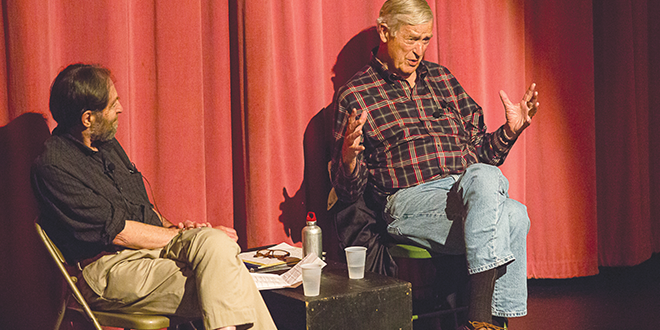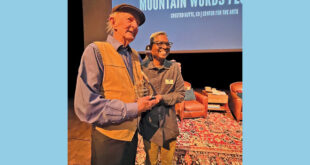The future of carbon and climate modeling
by Allen Best
Last week Part 1 looked at John Harte’s experiment, started in Gothic in 1991, to study global warming. This week we relay what has evolved from that first project.
This article is from Big Pivots, an e-magazine focused on climate change, energy and water in Colorado. For a free e-mail subscription, go to BigPivots.com.
Scientist John Harte was and remains friends with Tim Wirth. They both were, and still are, part-time residents of Crested Butte. Harte says his friendship with Wirth was only incidental as he worked out the design for Warming Meadows in 1988, even as Wirth was busy in Washington, D.C. trying to draw national attention to the threat of global warming.
In his role as a U.S. senator from Colorado, Wirth helped with the staging of testimony in June 1988 by James Hansen from NASA’s Goddard Institute for Space Studies. With sweat dripping from his brow, Hansen said there was a “high degree of confidence that greenhouse gas emissions and global warming were incontrovertibly related. “It is already happening now,” he said.
Hansen’s testimony was the No. 2 story in the New York Times the next day. The lead story was that a new law had failed to stem the flow of immigrants from Mexico.
People in Colorado mountain towns that summer took note of Hansen’s testimony, because it was a hot summer, by mountain standards. Yet the threat of global warming, like Washington, D.C., still seemed distant.
The threat of warming is less distant now, if overshadowed for much of this year by concerns that a stray cough from an unmasked stranger could send you to the hospital—that is, until the wildfires arrived with their suggestion that this will become the new normal.
But for places like Crested Butte, there’s good reason to wonder whether tourism, like the mining that preceded it, will in time wane. Since the 1990s, Crested Butte’s summer tourism has bustled with greater liveliness than its ski economy. It self-promotes, not without good cause, as the Wildflower Capitol of Colorado. One of its signature pre-COVID events was a wildflower festival.
Can sagebrush ecosystems be celebrated as readily? Today, as you drive the 29 miles down valley along the East River to Gunnison, dropping 500 feet in elevation, the montane ecosystem gives away to high desert. The annual precipitation decreases by more than half. Where Crested Butte is surrounded by wildflowers, Gunnison is in a sea of sagebrush. That is likely Crested Butte’s future.
The subterranean dance
But as much as Harte hoped to predict above-ground impacts, he was just as attentive to what was happening underground.
“Climate change can alter the quantities of carbon sequestered in plants and soil, resulting in feedbacks that either enhance or retard the anthropogenic buildup of atmosphere carbon dioxide,” Harte explains in Ecosystem Consequences of Soil Warming.
“Such feedbacks are especially likely in montane and high-latitude ecosystems where soils are carbon rich, vegetation is sensitive to climate variables, such as snowmelt date and length of growing season, and climate change is expected to be large due to snow albedo feedback.”
From 1991 forward, he was trying to discern the implications for atmospheric carbon in this dance with the subterranean. For 28 consecutive years, twice each summer, Harte took four soil carbon measurements in each of the five heated and each of the five control plots, resulting in a unique and accurate record of changes in soil carbon.
The measurements were to depths of 10 cm. and occasionally to 25 cm. Those areas nearest the surface have the most carbon, he points out.
“We found a 25 percent loss of soil carbon going to the atmosphere as CO2, which, on a large spatial scale, would translate to a huge incremental warming,” he says.
Harte hoped for a still-longer run at Gothic with Warming Meadows. Continued warming until 2050 could, he pointed out, predict climate effects in that ecosystem to the end of the century. But the costs, if not staggering at about $15,000 a year, including $6,000 for electricity (produced mostly at coal-burning power plants), persuaded funders it was time to move on.
“It led the way for a type of research that is now very common,” says Ian Billick, director of RMBL who first arrived in Gothic as an undergraduate student in 1988. The experiment cannot perfectly foretell the effects of warming on other regions, says Billick, but the intense study can “provide insights, even if not perfectly, that help us think about the entire world.”
By way of example, Billick points to work on human diseases that often start with fruit flies or mice. “Not because they are perfect models for humans, but because they are way easier and cheaper to start with. We can’t study everything about everywhere, so places like Gothic serve as starting points that serve as a model for understanding all of the Earth’s ecosystems,” he says.
Seeking mountain patterns
Six years ago, a new effort was launched in the hopes of finding patterns in mountainous places across the world, to better detect general trends in the effects of warming on species loss on diversity and ecosystem function. It’s called WaRM, which stands for Warming and (species) Removal in Mountains (some acronyms come easier than others).
Among the 11 cold-weather sites in the WaRM network around the globe is Kluane Lake in the Yukon Territory. The chief investigator at that site, Jennie R. McLaren, who teaches at the University of Texas at El Paso, observes on her website that woody shrubs are replacing grasses in both tundra ecosystems and the Chihuahua Desert where she lives.
In July 2019, after the power was cut off to the warmed meadows, a small backhoe trundled up the trail to excavate narrow pits 1.5 meters deep. Several dozen scientists then gathered for a month to collect samples of 30 to 40 plant species and 30,000 or so microorganisms.
“Essentially we had to destroy the [Warming Meadows plots], but it’s really important because half the carbon is stored below 20 cm,” explained Stephanie Kivlin a month later.
“Putting this all together will be really interesting, but this will take time,” said Kivlin, who teaches at the University of Tennessee–Knoxville.
The core question motivating these pits was whether the soil carbon at this greater depth responded differently from that closer to the surface. Sensors had all along kept track of heat and moisture relatively close to the surface.
A secondary and related question is whether rising temperatures above ground alter interaction among the species living underground.
Better climate models
Researchers hope this second phase of Warming Meadows, the underground work, may yield a high-profile paper, perhaps in Science, the prestigious journal. The goal, says Kivlin, is to “understand how ecosystems are going to respond to warming. That includes plants above ground, plants below ground, and all the carbon and nutrients and microorganisms, including the carbon that plants are picking up from the atmosphere and putting into their roots. We want to understand how the entire ecosystem responds.”
Another researcher, Aimée T. Classen, also traveled to Gothic to study the link between soil and climate change. “I have always had an interest in soil, and it turns out that soil harbors a lot of carbon,” she says. “It harbors more than the atmosphere or the terrestrial biosphere.”
Classen taught middle school for three years awhile working weekends in a soil laboratory before returning as a student to earn a Ph.D. “It was such a neat mashup of ecology and chemistry,” she says. Unlike the layperson, she understands something about “all these crazy microorganisms” that are part of the web of life. Now directing the Aiken Forest Science Laboratory at the University of Vermont, she wonders about things about which most of us have absolutely no notion. For example, how will those tens of thousands of microorganisms in the soil react to warming temperatures? And do the microorganisms absorb the atmospheric carbon through the roots of plants? Or will they emit more carbon themselves? “I spend all my time thinking about this,” she says.
This post-Warming Meadows study, Classen says, will almost certainly be used to build better climate-change models. Billick, the RMBL director, agrees. “This will be the first good estimate of deep soil carbon response to warming,” he says.
So, as you take your next hike out into the backcountry, consider that what lies underfoot may be just as interesting and important as what you see above ground. As for those wildflowers, try to image sagebrush as being just as beautiful. Not the easiest thing to do, but try.
 The Crested Butte News Serving the Gunnison Valley since 1999
The Crested Butte News Serving the Gunnison Valley since 1999





